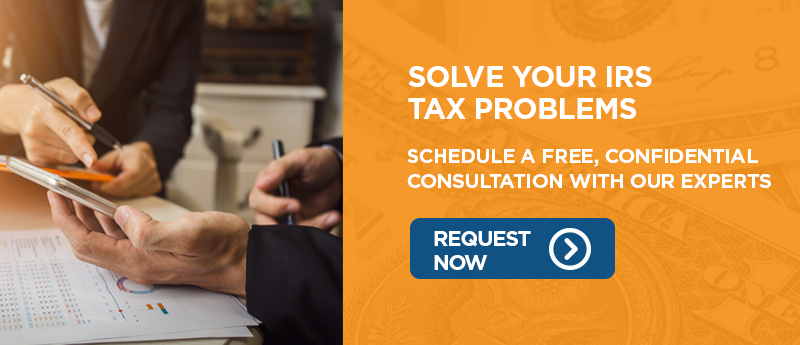
If you could not pay your taxes in full, you owe back taxes to the IRS (and possibly to the state you live in if there is a state income tax). The thing about back taxes is that they accrue interest on the unpaid balance from the time of nonpayment until it is completely paid off. So you wind up paying more than the original amount.
On top of that, the IRS assesses penalties for late payments, plus you may have to pay a fee to set up various payment plans or other methods of paying off your tax debt.
The interest, fees, and penalties are why you need to move quickly to take care of your IRS debt.
What Does the IRS Do?
The IRS doesn’t immediately jump on you for not paying taxes on time. First, you will receive a letter or two letting you know that you haven’t paid your tax bill and providing information on how to take care of it.
Then, if you don’t respond or pay, the IRS has a few more tools in its toolbox to compel or simply take payment, including:
The IRS does have a program that could help. It’s called the Fresh Start program. Through this 2011 initiative, the IRS changed the way it does business in a couple of areas. The idea is to give Americans a pathway to paying off their tax debts using a less aggressive tone.
At the time, then IRS Commissioner Doug Shulman said, "We are making fundamental changes to our lien system and other collection tools that will help taxpayers and give them a fresh start. These steps are good for people facing tough times, and they reflect a responsible approach for the tax system.”
In particular, the IRS made the following changes to its collection practices:
- Substantially increased the financial threshold for issuing a lien and reducing the number of tax liens.
- Making it simpler for taxpayers to get a lien withdrawal after paying off the tax debt.
- Withdrawing most liens when a taxpayer started a Direct Debit Installment Agreement.
- Simplified access to installment agreements for small businesses.
- Expanding streamlined Offers in Compromise to more taxpayers.
Since the beginning of the Fresh Start program, fewer taxpayers are constrained by liens, and the IRS doesn't act as scary.
Options for Paying Off Your Back Taxes
There are several different ways to pay off your tax bill depending on your financial health and ability to pay.
Installment Agreement
By entering into an installment agreement with the IRS, you maintain your good standing as long as you make your payments on time and with at least the minimum amount due. If you can pay more each time, you can pay your debt off faster.
Ideally, the IRS would like you to pay off within three years, but you can take as many as six years. Offer a monthly payment as high or higher than the IRS could get if it initiates a negotiated agreement. In this case, you approach first, so you can make the first offer. Just don't try to low-ball the agency, or it won't agree.
Usually, the payments are monthly and are set according to existing IRS criteria. For instance, subtract household expenses from your total income, then pay the difference to the IRS.
Remember that as long as you have a balance, interest, and penalties continue to accrue until full pay-off. And Do. Not. Miss. Payments. That way lies a road to liens and asset seizures.
Just so you know, the IRS charges a set-up fee for payment plans in some situations. It depends on how long you expect to take to pay and whether you set up the payment plan online or with an agent.
If at any time you think you will miss one or more payments, call the IRS immediately to try to work it out. If you are upfront with Uncle Sam, you are more likely to get favorable treatment.
Partial Payment Agreement
Somewhat like an installment plan, you make a deal with the IRS to pay a reduced amount over a long-term payment plan.
Offer in Compromise
Suppose you just can't pay off the full amount. In that case, you may be able to negotiate an Offer in Compromise, in which you pay a small portion of your tax debt in a lump sum or as a short-term payment plan.
If you qualify, this option can save thousands of dollars in taxes, penalties, and interest, but you must be eligible.
Be Declared Not Currently Collectible
If you can show you have no possible way to pay your tax debts, then the IRS may voluntarily agree not to collect on that debt for a year or more. You can be declared Currently Not Collectible (CNC) after the IRS receives evidence that you have no ability to pay.
Once declared CNC, you can file for a collection appeal to stop an IRS lien, levy, seizure, or denial or termination of an installment agreement. You have a chance to explain how you believe you can resolve the issue without the levy or seizure.
File Bankruptcy
Your income tax liability may be eligible for discharge under Chapter 7 or Chapter 13 bankruptcy. However, you should only consider it if you meet the requirements for discharging your taxes. Chapter 7 allows a full discharge of allowable debts. Chapter 13 has a payment plan to repay some debts while discharging others.
Wage Garnishment Release
If you owe back taxes, the IRS may levy or garnish your wages, salary, or federal payments until:
- Your tax debt is paid in full.
- The levy is released.
- The time expires for legally collecting the tax.
You might be able to negotiate a release or modification if you don’t have the income to survive with the garnishment in place.
Innocent Spouse Relief
If your tax problems are due to a spouse’s tax liability, you might be able to get out from under it through Innocent Spouse Relief. You must prove to the IRS that your circumstances fit within their guidelines for relief. If so, then you are not subject to the taxes belonging to your spouse or ex-spouse.
Being in hock to the Internal Revenue Service is stressful and downright no fun. But you have options that don’t involve breaking the bank or going to jail.
To get settled with the IRS, contact Top Tax Defenders today. We can help you decide the best way forward for your specific situation.




